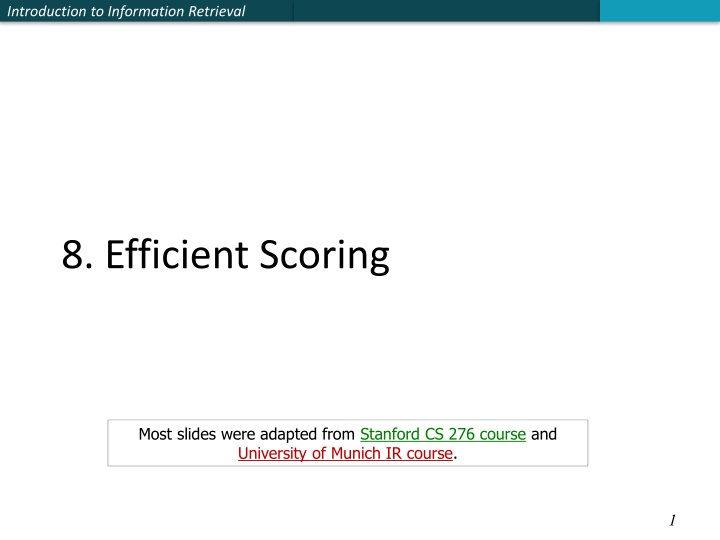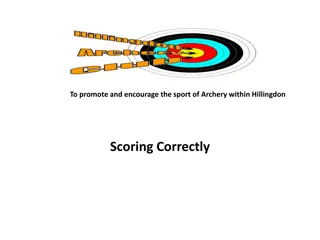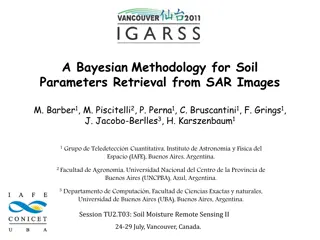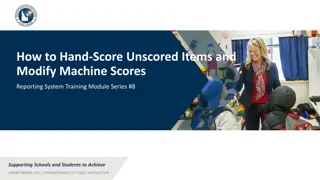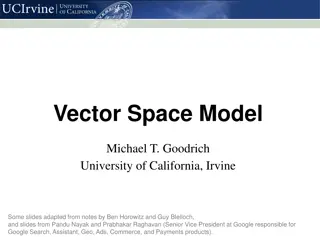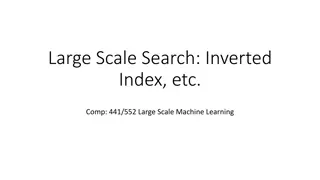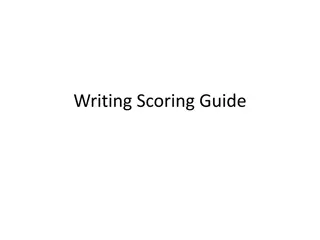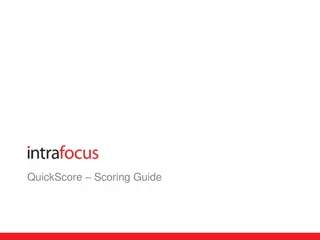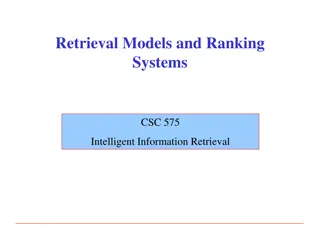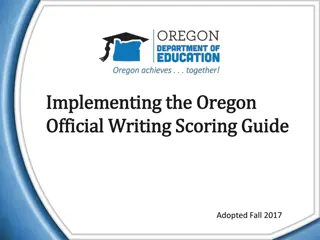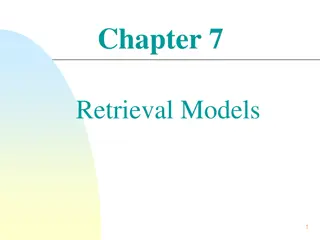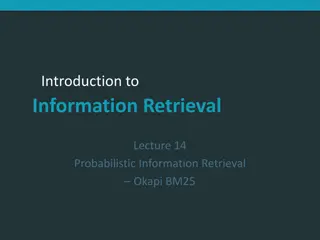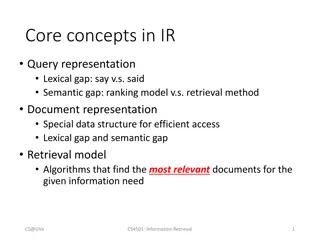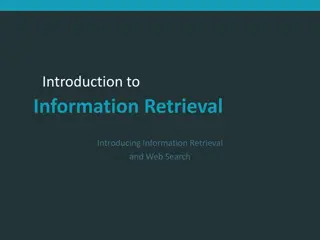Efficient Scoring Techniques in Information Retrieval
Today's focus in Information Retrieval is on efficiently scoring and ranking documents matching a query from an inverted index. The goal is to assign scores to each document and select the top K highest scoring ones. Cutting down CPU usage for scoring while maintaining result quality is essential. Techniques like Term At A Time (TAAT) and Document At A Time (DAAT) have implications on retrieval index structure. Efficient cosine ranking methods aim to find the K most relevant documents to a query without computing all cosine values.
Download Presentation

Please find below an Image/Link to download the presentation.
The content on the website is provided AS IS for your information and personal use only. It may not be sold, licensed, or shared on other websites without obtaining consent from the author.If you encounter any issues during the download, it is possible that the publisher has removed the file from their server.
You are allowed to download the files provided on this website for personal or commercial use, subject to the condition that they are used lawfully. All files are the property of their respective owners.
The content on the website is provided AS IS for your information and personal use only. It may not be sold, licensed, or shared on other websites without obtaining consent from the author.
E N D
Presentation Transcript
Introduction to Information Retrieval 8. Efficient Scoring Most slides were adapted from Stanford CS 276 course and University of Munich IR course. 1
Introduction to Information Retrieval Today s focus Retrieval get docs matching query from inverted index Scoring+ranking Assign a score to each doc Pick K highest scoring docs Our emphasis today will be on doing this efficiently, rather than on the quality of the ranking 2
Introduction to Information Retrieval Background Score computation is a large (10s of %) fraction of the CPU work on a query Generally, we have a tight budget on latency (say, 250ms) CPU provisioning doesn t permit exhaustively scoring every document on every query Today we ll look at ways of cutting CPU usage for scoring, without compromising the quality of results (much) Basic idea: avoid scoring docs that won t make it into the top K 3
Ch. 6 Introduction to Information Retrieval Recap: Queries as vectors Vector space scoring We have a weight for each term in each doc Represent queries as vectors in the space Rank documents according to their cosine similarity to the query in this space Or something more complex: BM25, proximity, Vector space scoring is Entirely query dependent Additive on term contributions no conditionals etc. Context insensitive (no interactions between query terms)
Introduction to Information Retrieval TAAT vs DAAT techniques TAAT = Term At A Time Scores for all docs computed concurrently, one query term at a time DAAT = Document At A Time Total score for each doc (incl all query terms) computed, before proceeding to the next Each has implications for how the retrieval index is structured and stored 5
Sec. 7.1 Introduction to Information Retrieval Efficient cosine ranking Find the Kdocs in the collection nearest to the query K largest query-doc cosines. Efficient ranking: Choosing the K largest cosine values efficiently. Can we do this without computing all N cosines?
Introduction to Information Retrieval Safe vs non-safe ranking The terminology safe ranking is used for methods that guarantee that the K docs returned are the K absolute highest scoring documents (Not necessarily just under cosine similarity) Is it ok to be non-safe? If it is then how do we ensure we don t get too far from the safe solution? How do we measure if we are far? 7
Introduction to Information Retrieval Non-safe ranking Non-safe ranking may be okay Ranking function is only a proxy for user happiness Documents close to top K may be just fine Index elimination Only consider high-idf query terms Only consider docs containing many query terms Champion lists For each term, precompute documents with highest weights High/low lists, tiered indexes Order postings by g(d) (query-indep. quality score) 8
Introduction to Information Retrieval Safe ranking When we output the top K docs, we have a proof that these are indeed the top K Does this imply we always have to compute all N cosines? We ll look at pruning methods So we only fully score some J documents Do we have to sort the J cosine scores? 9
Sec. 7.1 Introduction to Information Retrieval Computing the K largest cosines: selection vs. sorting Typically we want to retrieve the top K docs (in the cosine ranking for the query) not to totally order all docs in the collection Can we pick off docs with K highest cosines? Let J = number of docs with nonzero cosines We seek the K best of these J
Sec. 7.1 Introduction to Information Retrieval Use heap for selecting top K Binary tree in which each node s value > the values of children Takes 2J operations to construct, then each of K winners read off in O(log J) steps. For J=1M, K=100, this is about 10% of the cost of sorting. 10 .9 .3 .3 .8 .1 .2 .1
Introduction to Information Retrieval WAND scoring An instance of DAAT scoring Basic idea reminiscent of branch and bound We maintain a running threshold score e.g., the Kth highest score computed so far We prune away all docs whose cosine scores are guaranteed to be below the threshold We compute exact cosine scores for only the un-pruned docs Broder et al. Efficient Query Evaluation using a Two-Level Retrieval Process. 12
Introduction to Information Retrieval Index structure for WAND Postings ordered by docID Assume a special iterator on the postings of the form go to the first docID greater than or equal to X Typical state: we have a finger at some docID in the postings of each query term Each finger moves only to the right, to larger docIDs Invariant all docIDs lower than any finger have already been processed, meaning These docIDs are either pruned away or Their cosine scores have been computed 13
Introduction to Information Retrieval Upper bounds At all times for each query term t, we maintain an upper bound UBt on the score contribution of any doc to the right of the finger Max (over docs remaining in t s postings) of wt(doc) finger t UBt = wt(38) 3 7 11 17 29 38 57 79 As finger moves right, UB drops 14
Introduction to Information Retrieval Pivoting Query: catcher in the rye Let s say the current finger positions are as below Threshold = 6.8 catcher UBcatcher = 2.3 273 UBrye = 1.8 rye 304 in UBin = 3.3 589 the UBthe = 4.3 762 P i 15
Introduction to Information Retrieval Prune docs that have no hope Terms sorted in order of finger positions Move fingers to 589 or right Threshold = 6.8 catcher UBcatcher = 2.3 273 Hopeless docs UBrye = 1.8 rye 304 Hopeless docs in UBin = 3.3 589 the UBthe = 4.3 762 Update UB s P i 16
Introduction to Information Retrieval Compute 589 s score if need be If 589 is present in enough postings, compute its full cosine score else some fingers to right of 589 Pivot again catcher 589 rye 589 in 589 the 762 17
Introduction to Information Retrieval WAND summary In tests, WAND leads to a 90+% reduction in score computation Better gains on longer queries Nothing we did was specific to cosine ranking We need scoring to be additive by term WAND and variants give us safe ranking Possible to devise careless variants that are a bit faster but not safe (see summary in Ding+Suel 2011) Ideas combine some of the non-safe scoring we considered 18
